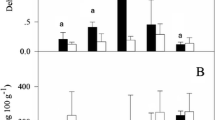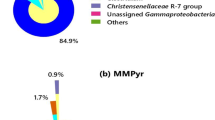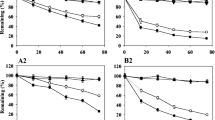Abstract
This study investigated the anaerobic degradation of the polycyclic aromatic hydrocarbons (PAHs) phenanthrene and pyrene in mangrove sediment from Taiwan. The anaerobic degradation of PAH was enhanced by the addition of acetate, lactate, pyruvate, sodium chloride, cellulose, or zero-valent iron. However, it was inhibited by the addition of humic acid, di-(2-ethylhexyl) phthalate (DEHP), nonylphenol, or heavy metals. Of the microorganism strains isolated from the sediment samples, we found that strain MSA3 (Clostridium pascui), expressed the best ability to biodegrade PAH. The inoculation of sediment with the strain MSA3 could enhance PAH degradation.
Similar content being viewed by others
Explore related subjects
Discover the latest articles, news and stories from top researchers in related subjects.Avoid common mistakes on your manuscript.
In recent years, anthropogenic practices such as industrial processing, petroleum spills, and incomplete combustion of fossil fuel have led to an accumulation of polycyclic aromatic hydrocarbons (PAHs) in the environment and PAH contamination is an increasing environmental concern (Simpson et al. 1996). Elevated concentrations of PAH are commonly recorded in marine and coastal sediments near urban and industrial cities (Connell et al. 1998). Mangrove ecosystems, important inter-tidal estuarine wetlands along the coastlines of tropical and subtropical regions, are frequently exposed to anthropogenic contamination by PAH (Kleskowski et al. 1994). Spilled and stranded oils containing large amounts of PAH penetrate and accumulate in mangrove sediments (Ke et al. 2002).
Microbial degradation is believed to be one of the major processes that clean up PAH-contaminated sediments. The aerobic degradation of PAH in mangrove sediments has been extensively documented (Tam et al. 2002; Guo et al. 2005; Yu et al. 2005), but little is known about the factors that affect the anaerobic degradation of PAH in mangrove sediment. The purpose of this study was to compare the anaerobic degradation of two PAHs in mangrove sediment from five sampling sites, investigate the effects of various factors on the anaerobic degradation of PAH in mangrove sediment, and isolate PAH-degrading bacteria from the sediment.
Materials and Methods
Two PAHs (phenanthrene and pyrene) with 99.0% analytical standards were purchased from the Aldrich Chemical Co. Inc. (Milwaukee, WI). Solvents were purchased from Mallinckrodt, Inc. (Paris, KY); all other chemicals were purchased from the Sigma Chemical Co. (St. Louis, MO). Stock solutions of individual PAH dissolved in dimethylsulfoxide were initially established at concentrations of 10,000 mg/L and diluted to 500 mg/L before use.
In July 2005, sediment samples were taken from the Guandu and Zhuwei Mangroves in northern Taiwan. The Guandu Mangrove is at the confluence of the Tanshui River and the Keelung River. The Zhuwei Mangroves Reserve Area in the Tanshui Township of Taipei County is on the north bank of the Tanshui River. Figure 1 shows the locations of the five sample collection sites. Sites A, B, and C were in the Guandu Mangroves, while sites D and E were in the Zhuwei Mangroves. Deep sediments (5–20 cm) were collected during low tides using a soil core. Sediments were randomly collected, in triplicate, from an area of around 1 m2 at the center of each mangrove swamp. Each sediment sample, around 2–3 kg in fresh weight, was actually a composite sample made up by thoroughly mixing sediments collected from several sampling points.
For sediment samples from sites A, B, C, D, and E, the organic carbon was 1.18%, 2.54%, 1.78%, 0.89% and 1.89%, respectively; the pH, determined in sediment/water mixtures (1:1, w/v), was 7.3, 7.4, 7.1, 6.5, and 7.6, respectively; the anaerobic bacterial count was 5.1 × 105, 6.4 × 106, 4.6 × 105, 6.4 × 104, and 6.4 × 105 CFU/g, respectively; phenanthrene concentration was 0.20 μg/g, 0.56 μg/g, not detected (ND), ND and ND, respectively; and the concentration of pyrene was ND, 0.28 μg/g, ND, ND and ND, respectively. The experimental medium consisted of (all concentrations in g/L): NH4Cl, 2.7; MgCl2 · 6H2O, 0.1; CaCl2 · 2H2O, 0.1; FeCl2 · 4H2O, 0.02; K2HPO4, 0.27; KH2PO4, 0.35; and resazurin, 0.001. The pH was adjusted to 7.0 following autoclaving; 0.9 mM titanium citrate was added as a reducing reagent.
Experiments were performed using 125 mL serum bottles containing 45 mL of medium, 5 g of mangrove sediment, and 50 μg/g of a mixture of the two PAHs (phenanthrene and pyrene). PAH degradation was first measured in the sediment samples from sites A, B, C, D, and E. The following factors were added to study their effects on the degradation of PAH: 20 mM sodium acetate, 20 mM sodium lactate, 20 mM sodium pyruvate, 1% (w/v) sodium chloride, 5 g/L humic acid, 0.96 mg/L cellulose, 10 g/L zero-valent iron, 5 mg/L di-(2-ethylhexyl) phthalate (DEHP), 5 mg/L nonylphenol, 2 mg/L heavy metals (Cd, Cu, Pb, and Zn), 20 mM sodium hydrogen carbonate, 20 mM sodium sulfate, 20 mM sodium nitrate, 50 mM BESA, 50 mM vancomycin, or 50 mM sodium molybdate-2-hydrate. We also inoculated the sediment with the PAH-degrading bacteria. Inoculated control samples were treated with non-sterile sediment and were shaken prior to incubation at 30°C and pH 7.0 in the dark. Sterile controls were autoclaved at 121°C for 30 min on two consecutive days.
All experiments were conducted in an anaerobic glove box (Forma Scientific, model 1025 S/N, USA) filled with N2 (85%), H2 (10%), and CO2 (5%) gases. Bottles were capped with butyl rubber stoppers and wrapped in aluminum foil to prevent photolysis, then incubated without shaking at 30°C in the dark. The bottle contents were periodically sampled in order to measure residual PAH concentration. All experiments were performed in triplicate.
PAH extraction and analysis were performed as described by Yuan et al. (2001). Recovery percentages were 96.5% and 97.5% for phenanthrene and pyrene, respectively. Detection limits were 100 μg/L for both compounds. The purified bacterium was identified as described by Chang et al. (2007a). The PAH degradation data collected for this study fit well with first-order kinetics: S = S 0exp(−k 1 t), t 1/2 = ln2/k 1, where S 0 is the initial concentration, S the substrate concentration, t the time period and k 1 the degradation rate constant. Significant differences were calculated using a standard variance F-test.
Results and Discussion
We first compared anaerobic degradation rates in mangrove sediment samples collected from five sampling sites (Table 1). The results showed that the degradation rates were higher for phenanthrene than for pyrene. The molecular weights for phenanthrene and pyrene are 178 and 202 g/mol, respectively. PAH with high molecular weights are more resistant to biotransformation than those with low molecular weights (Yu et al. 2005). We did not detect PAH degradation products at any stages. The high-to-low order of PAH degradation rates in the five sediment sampling sites was B → A → C → D → E. The results showed that samples from site B had higher phenanthrene and pyrene degradation rates than those from the other sampling sites. It was also found that sediment samples from site B had higher phenanthrene and pyrene concentrations than those from the other sampling sites. The sediment samples from site B were collected from the Guandu Mangrove, where they have been affected by vehicle exhaust deposition and the discharge of industrial, livestock and household waste and wastewater. We will restrict our discussion to results from the sediment sample from site B in the next experiment.
Table 2 shows the effects of various substrates on the anaerobic degradation of PAH. PAH degradation was enhanced compared to the inoculated control following the addition of acetate, lactate, or pyruvate. A possible explanation is that these carbon sources promote the growth of methanogen, which results in faster degradation (Oremland 1988). The metabolizing of lactate or pyruvate by acidogen produces either hydrogen or hydrogen carbonate, both of which enhance methanogen production (Oremland 1988). It is also possible that the action of sulfate-reducing bacteria on lactate produces pyruvate plus two electrons and that the action of pyruvate produces acetate plus two electrons; both of these processes would result in faster degradation (Legall and Fauque 1988).
The addition of 1% sodium chloride enhanced the anaerobic degradation of PAH. The optimum salinity for the degradation of phenanthrene was around 1–2%; high salinity (3.5%) has an inhibitory effect on the degradation of phenanthrene (Tam et al. 2002). The addition of humic acid inhibited the anaerobic degradation of PAH. Humic acid plays an important role in the sorption and binding of PAH and PAH metabolites (Conte et al. 2001). The addition of cellulose enhanced the anaerobic degradation of PAH because it stimulates anaerobic respiration (Quantin et al. 2005). The addition of zero-valent iron enhanced the anaerobic degradation of PAH. Zero-valent iron can serve as the electron donor and was capable of efficiently removing PAH (Chang et al. 2007b).
Liu et al. (2000) found PAH, DEHP, nonylphenol, and heavy metals in samples collected from various Taiwanese rivers and we therefore studied the effects of these pollutants on the anaerobic degradation of PAH in mangrove sediment. The data in Table 3 also show that PAH anaerobic degradation was inhibited by the addition of DEHP, nonylphenol, or heavy metals. It may be that DEHP and nonylphenol are also used as carbon sources, thus inhibiting PAH anaerobic degradation. Furthermore, the toxicity of heavy metals such as Cd, Cu, Pb, and Zn are known to decrease microorganism activity (Giller et al. 1998).
Table 3 indicates that the anaerobic degradation of PAH was enhanced under methanogenic and sulfate-reducing conditions and inhibited under nitrate-reducing conditions. The order of anaerobic degradation rates of PAH in mangrove sediment under these conditions was observed to be sulfate-reducing conditions > methanogenic conditions > nitrate-reducing conditions. Table 4 shows that the anaerobic degradation of PAH was inhibited by the addition of molybdate (a selective inhibitor of sulfate-reducing bacteria), BESA (a selective inhibitor of methanogen), or vancomycin (a selective inhibitor of eubacteria) (Lovely and Philips 1988; Distefano et al. 1992). The results obtained under the three anaerobic conditions and in the presence of the three microbial inhibitors indicate that sulfate-reducing bacteria, methanogen and eubacteria are involved in PAH degradation; sulfate-reducing bacteria may play a major microbial role in the PAH degradation, but methanogen and eubacteria are also involved. Coates et al. (1996) found phenanthrene oxidation to be due to the effects of sulfate-reducing bacteria.
We also isolated pure bacterial strains from the mangrove sediment samples and found six bacterial strains capable of anaerobically metabolizing PAH as carbon sources. The isolate showing the greatest degrading power was strain MSA3. Phenanthrene and pyrene degradation rates for the strain are shown in Table 5. These results showed the utilization of phenanthrene and pyrene as carbon sources for growth by the strain MSA3. The strain was relatively close to Clostridium pascui, with a similarity of 99.0%; the strain was gram-positive, rod-shaped and formed white colonies. Clostridium spp. capable of degrading PAH has been described (Yuan et al. 2007). Clostridium spp. may present frequently in the Taiwan aquatic environment.
As shown in Table 5, PAH degradation in sediment-free culture samples was higher than that in the sediment samples. One possible explanation for this significant difference is that the tendency of PAH to adsorb to sediment particles may reduce the degrading effectiveness of microorganisms by reducing the bioavailability of PAH, thus retarding the biodegradation process (Yuan et al. 2001). Table 5 also shows that the highest PAH degradation rate was found in the non-sterile sediment with the inoculation strain MSA3, whereas the non-sterile sediment without any inoculation had a lower degradation rate. These results suggested that the inoculation of sediment with the strain MSA3 could enhance PAH degradation. This is consistent with the findings of Yu et al. (2005), who reported that the degradation of PAH was enhanced by a bacterial consortium enriched from mangrove sediments.
In summary, the mangrove sediment samples used in these experiments were all capable of anaerobically degrading PAH. The addition of acetate, lactate, pyruvate, sodium chloride, humic acid, cellulose, zero-valent iron, DEHP, nonylphenol, or heavy metals affected the anaerobic degradation of PAH in mangrove sediment. The results support the feasibility of the removal of PAH in mangrove sediment by anaerobic degradation. Our next goal is to characterize the structure of the microbial community involved in the anaerobic degradation of PAH in mangrove sediment.
References
Chang BV, Chiang BW, Yuan SW (2007a) Anaerobic degradation of nonylphenol in soil. J Environ Sci Health B 42:63–69
Chang MC, Shu HY, Hsieh WP, Wang MC (2007b) Remediation of soil contaminated with pyrene using ground nanoscale zero-valent iron. J Air Waste Manage Assoc 57:221–227
Coates JD, Anderson RT, Lovely DR (1996). Oxidation of polycyclic aromatic hydrocarbons under sulfate-reducing conditions. Appl Environ Microbiol 62:1099–1101
Connell DW, Wu RSS, Richardson BJ, Leung K, Lam PSK, Connell PA (1998) Occurrence of persistent organic contaminants and related substances in Hong Kong marine areas: an overview. Mar Pollut Bull 36:376–384
Conte P, Zena A, Pilidis G, Piccolo A (2001) Increased retention of polycyclic aromatic hydrocarbons in soils induced by soil treatment with humic substances. Environ Pollut 1:27–31
Distefano TD, Gossett JM, Zinder SH (1992) Hydrogen as an electron donor for dechlorination of tetrachloroethene by an anaerobic mixed culture. Appl Environ Microbiol 58:3622–3629
Giller KE, Witter E, McGrath SP (1998) Toxicity of heavy metals to microorganisms and microbial processes in agricultural soils: a review. Soil Biol Biochem 30:1389–1414
Guo CL, Zhou HW, Wong YS, Tam NFY (2005) Isolation of PAH-degrading bacteria from mangrove sediments and their biodegradation potential. Mar Pollut Bull 51:1054–1061
Ke L, Wong TWY, Tam NFY (2002) Fate of polycyclic aromatic hydrocarbon (PAH) contamination in a mangrove swamp in Hong Kong following an oil spill. Mar Pollut Bull 45:339–347
Kleskowski EJ, Corredor JE, Morell JM, Del Castillo CA (1994) Petroleum pollution and mutation in mangroves. Mar Pollut Bull 28:166–169
Legall J, Fauque G (1988) Dissimilatory reduction of sulfur compounds. In: Zehnder AJB (Ed) Biology of anaerobic microorganisms. John Wiley and Sons, New York, pp. 587–640
Liu C, Wang SK, Lu YB (2000) Chemical characterization of Tanshui River sediment in northern Taiwan. Toxicol Environ Chem 76:205–218
Lovely DR, Philips ZJP (1988) Novel mode of microbial energy metabolism: organic carbon oxidation coupled to dissimilatory reduction of iron or manganese. Appl Environ Microbiol 54:1472–1480
Oremland RS (1988) Biogeochemistry of methanogenic bacteria. In: Zehnder AJB (ed) Biology of anaerobic microorganisms. John Wiley and Sons, New York, pp. 641–706
Quantin C, Joner EJ, Portal JM, Berthelin J (2005) PAH dissipation in a contaminated river sediment under oxic and anoxic conditions. Environ Pollut 134:315–322
Simpson CD, Mosi AA, Cullen WR, Reimer KJ (1996) Composition and distribution of polycyclic aromatic hydrocarbons in surficial marine sediments from Kitimat Harbour, Canada. Sci Total Environ 181:265–278
Tam NFY, Guo CL, Yau KWY, Wong YS (2002) Preliminary study on biodegradation of phenanthrene by bacteria isolated from mangrove sediments in Hong Kong. Mar Pollut Bull 45:316–324
Yu SH, Ke L, Wong WS, Tam NFY (2005) Degradation of polycyclic aromatic hydrocarbons (PAHs) by a bacterial consortium enriched from mangrove sediments. Environ Int 31:149–154
Yuan SY, Chang JS, Chang BV (2001) Biodegradation of phenanthrene in river sediment. Chemosphere 43:273–278
Yuan SY, Chang BV (2007) Anaerobic degradation of five polycyclic aromatic hydrocarbons from river sediment in Taiwan. J Environ Sci Health B 42:63–69
Acknowledgment
This Research was supported by the National Science Council, Republic of China, Grant Number NSC96-2745-B-031-004-Urd.
Author information
Authors and Affiliations
Corresponding author
Rights and permissions
About this article
Cite this article
Chang, BV., Chang, I.T. & Yuan, S.Y. Anaerobic Degradation of Phenanthrene and Pyrene in Mangrove Sediment. Bull Environ Contam Toxicol 80, 145–149 (2008). https://doi.org/10.1007/s00128-007-9333-1
Received:
Accepted:
Published:
Issue Date:
DOI: https://doi.org/10.1007/s00128-007-9333-1





